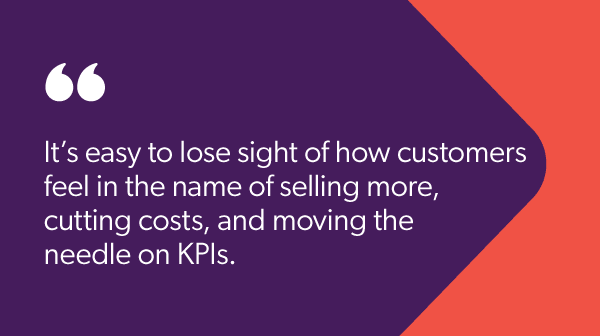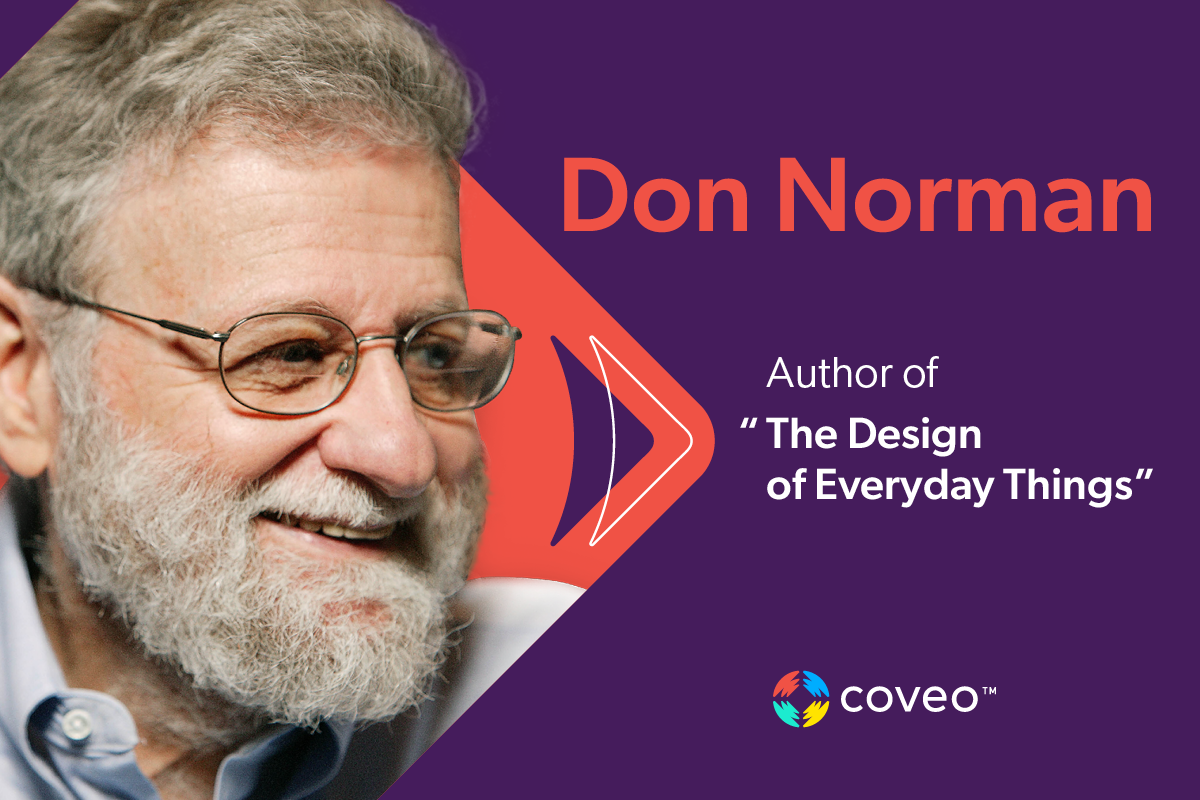So you’ve stood up your community and customers have yet to march through the streets, singing your praise. Maybe your self-service adoption is still middling, while the line between your community and deflected contact center costs remains difficult to draw. Oddly, your underlying technology stack is solid (at least on paper).
Maybe your heart’s just not in it.
I’m talking about the role of user experience (UX) in the so-called experience economy. This also happens to be the topic of conversation for a recent on-demand webinar from Coveo, Emotion of Design with Don Norman & 7Summits. What follows are a couple of takeaways that designers can expect to gain from this rich session.
1. Understand Where the Experience Actually Happens (and For Whom)
When designing products, services, and experiences—anything, really—it’s easy to make assumptions. Norman relates a favorite story about the time the brain trust at a global consumer electronics behemoth decided to add a “get better sound” button to one of their boomboxes.
The engineers were horrified. Why add yet another button, especially one that suggests the boombox’s standard sound was subpar? As it turns out, this button created an interesting, engaging, and memorable experience at the point of the sale. It created an experience on the showroom floor—people only had to push this button once to be sold.
And it was a success.
In this case, the engineers were empathizing, to be fair, but at the wrong touchpoint in the journey. It’s a valuable lesson for UX designers. “The experience is really a global insight about how people live and what they would enjoy doing and how you can put things together,” says Norman. “It’s a big system. Designers haven’t learned that lesson.”
The takeaway: UX takes a village. Bringing in stakeholders beyond the three feet in front of us can help reveal blind spots in the experience, or new perspective on what customers actually need in a given moment.
2. The Benefits of Emotional Design Aren’t Always Tied to Numbers
Designers are constantly walking the line between building something wonderful for the customer and selling the value of that design to company stakeholders. “A lot of purchase decisions are based on emotion,” says Norman. “And you have to convey that emotion to the decision makers in the company. But they always like to see numbers.”
For those of us designing service communities, that might mean measuring what people search for, click on, etc. It might also mean drawing lines between the way the self-service experience is designed and its demonstrable bottom-line impact (sales, reduction, etc.).
Yet, there are benefits to good UX that aren’t always tied to numbers.

Case deflection is a great example. At face value, fewer cases might seem like a win-win. “Service centers are usually called a cost center. And so they go to great lengths to try to decrease costs. But the whole experience is horrible, just horrible. And what it really means to me is ‘your opinion doesn’t matter to us, your time doesn’t matter to us.’”
Emotionally speaking, that kind of experience is extremely off-putting for most customers.
A personalized and engaging service experience, on the other hand, can have a tremendous residual effect on customer sentiment, brand image, and loyalty—just not always in the most tangible or measurable way. Still, says Norman, “if you really do this, well, they’re going to like you so much, they’ll come back and they’ll order more, they might even order more on the phone.”
The takeaway: It’s easy to lose sight of how customers feel in the name of selling more, cutting costs, and moving the needle on KPIs.
3. Nothing Beats Getting Your Hands Dirty
Speaking of data, the numbers only paint part of the picture. Says Norman, “my standard thing about questionnaires is, can you trust the answers you gave in the last questionnaire you filled out? No, most people say no.” And even the best sentiment analysis can’t match sitting in on a customer service phone call and hearing the frustration—the language and emotion. “Designers,” says Norman, “need more hands-on experience. What I really like is when designers go to people’s homes and watch them, don’t ask them questions.”
Today, there are myriad ways to get a lot closer to the emotion of a customer experience. Focus groups are a classic example. UX labs come to mind, too. Depending on the product or service, you can even send a team out into public to observe people interacting with the experience “in the wild.”
In many ways, a self-service community is “the wild.”
Yet, as Norman points out, emotional design requires more than training and underlying technologies. Go live, he says. Observe. “I really feel that the education that designers get is impoverished. They don’t learn enough about the world. They don’t learn about business. They don’t learn about the different cultures and societies in the world.”
The takeaway: One way to limit the assumptions we make about how people interact with the experiences we create is to get as close to the experience as possible—to observe real people doing real things “for keeps.”

All Considered: There’s Power in Story
Don Norman’s take on “story” is a fitting way to round out this discussion of emotional design. “[Often], the story turns out to make the difference […] What I recommend to designers as they make presentations, is they also have a few stories, which show how this thing plays out in life […] Even the most rigorous engineering disciplines usually try to put it in [stories] to get your emotions going about how wonderful and exciting this will be.”
In other words, emotional design goes far beyond tech stack, features, and functionality. It attempts to account for the whole narrative—the entirety of the experience from the customer’s point of view. As simple as facilitating better, more pleasing user interactions on a self-service community might sound, it’s rooted in something far deeper.
Finding and engaging with that customer story is usually where the most magic happens.


